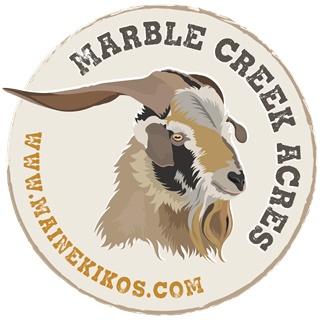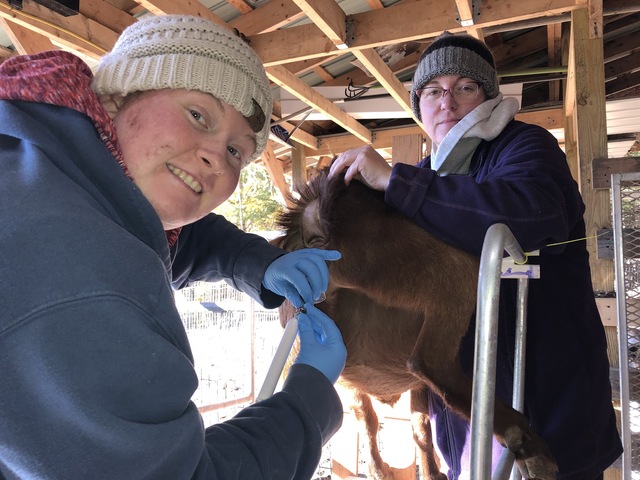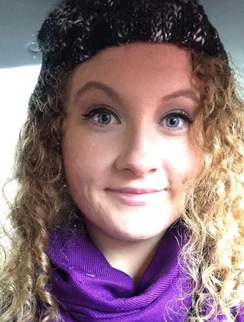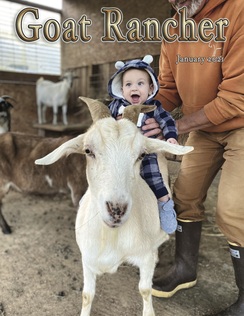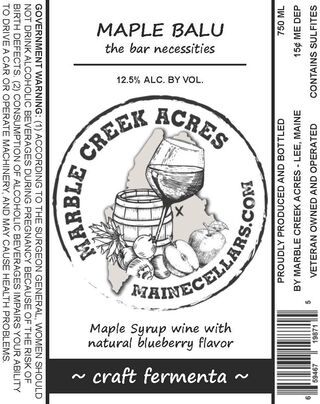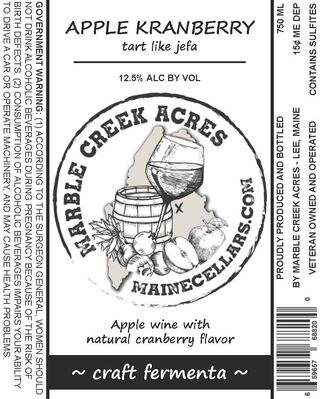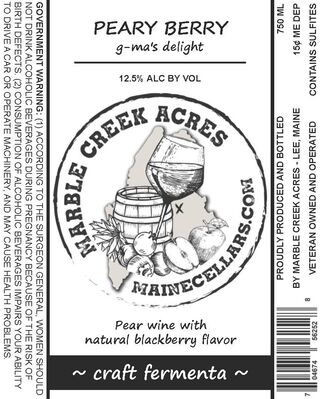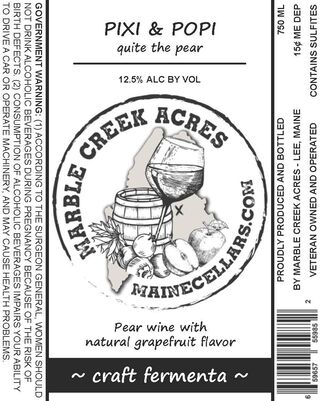Adding Artificial Insemination to our Goat Husbandry Arsenal
Friday, January 1, 2021
With the 2020 Cream of the Crop Kiko Sale in Corydon, Indiana under our belts, and our three new does integrated into our herd and settling in quite nicely, it was time to make their Facebook debuts on our farm page and personal pages. We documented our whole trip to the sale on our pages, as we always do, so we can remember our trips, but also for marketing purposes. This year wasn’t any different in regards to comments on our Facebook posts’ pictures. Many people post things such as, “safe travels”, or “how cool”. Each year, however, it seems like one person always asks, “Why would you travel 20 hours just to buy goats?” This is a question we love! A chance to publicly explain how special Kikos are, discuss our genetic bottleneck in New England, and the importance of bringing in lines from around the country so that we can continue to provide our customers with optimum and different genetics year after year. And while we will always jump at the chance to road-trip, with artificial insemination (AI) now in our arsenal, it is no longer necessary to travel such great lengths in search of goats if we don’t want or have the time to because of scheduling conflicts.
I am happy to announce that we have just (November) confirmed our first artificial insemination pregnancy on our naturally polled doe Taho, who came from Lookout Point Ranch in Oregon. Yes, you heard that right, naturally polled. Our understanding is that Taho possibly was passed a recessive gene that was not present in the original imports from New Zealand. We are excited to see what Taho’s DNA combined with MRG 1123 will bring us for kids in the spring. We are thrilled to have brand new genetics born to the farm, without ever even having to travel, not even to the post office to collect the semen!
Last spring was our first attempt at AI. We selected one goat for AI and prepared her for several weeks leading up to the procedure. A family friend of ours had just graduated with her degree in Animal and Veterinary Sciences from the University of Maine. While interning at the University farm she learned how to artificially inseminate many cows on the farm. This procedure is entirely different from conducting AI on a goat, and as she pointed out, it is also much easier on a cow! Nevertheless, after doing some extra reading and research, she came to our farm and attempted to AI one of our goats. It was unfortunately not successful; some things were just not up to snuff in regards to the AI process. While it was disappointing when we learned that the doe did not get pregnant, it was a major learning point for inseminating this fall.
With the spring failure under our belts, we decided to give it another go this fall. We selected three does, as we had three straws of semen we wanted to use up, and began the AI protocol Dr. An Peischel had collaborated on with us. We also decided to do the procedure ourselves this time. Without going into a ton of detail, surely an article to be written later in more detail by Dad, here is a quick rundown of what the process looked like as we prepared and executed AI for a second time. There are two ways that AI can be performed: cervical insemination or laparoscopically. We conducted cervical insemination, as we are definitely not trained for laparoscopic insemination. There is a specific protocol, taking several weeks, that leads up to the day of inseminating that includes flushing and several doses of drugs, to properly prepare the doe for AI. On the day of, we got the does in the stand, which we had to redesign after we had the first doe up there, and checked the state of the mucus inside the vaginal cavity (looking for a specific consistency of the mucus). After witnessing the right consistency, we followed the protocol and inserted the semen. The protocol and manual we used are extremely detailed, and if you are interested in additional details, please reach out!
With the protocol complete and the AI day quickly approaching, we were still unsure who would be conducting the procedure. Mom was already out of the question as she does not partake in any of the ‘gross’ dealings, but simply, but expertly (most of the time) holds the animal while Dad and I do the work. I wanted my dad to do the insemination because I was very nervous I would do it wrong, but it inevitably fell to me, the residential ‘vet’ on our ranch, complete with YouTube training. My dad has bad eyes, don’t tell him I said that, and even with all the lights in place, could not see anything inside the speculum. Now that we have confirmed Taho pregnant, I am ecstatic that it was me who got to perform the procedure.
As I mentioned above, we selected three goats for AI, but only Taho got pregnant. Here we encountered our biggest mistake. Lesson learned, if there is even a chance the goat could be pregnant already, do not perform this procedure on them. Back in July, one of our sires (who has now gone to a new farm), in a chaotic fury, busted through two gates to get to the herd of girls. He was with them for mere minutes but got at least six pregnant in that amount of time, who knows how many more at this point. Balu and Yari (the other does we selected for AI) were unfortunately pregnant, which we had not taken into consideration. When we gave these does their Lutalyse dose (used to bring them into heat), we believe it caused them to miscarriage, a known effect of the drug. We were able to deposit the semen in Yari, but it did not take. With Balu, however, we could not deposit the semen. So a lesson was learned for next year. 33% isn’t bad for the first time, at least in my opinion!
While many of our fellow ranchers in the south and southwest have ready access to a veterinarian who can conduct the AI procedure, who have had years of practice doing so, we, unfortunately, do not have this luxury in Northern Maine. We even struggle to find a veterinarian who is willing to travel to northern Maine to conduct simpler procedures. Inevitably, we have had to learn to do everything ourselves via research and YouTube, which, in the end, is much more cost-effective than bringing in a veterinarian every time you need something done. From giving medicines orally, intramuscularly, and subcutaneously, to drawing blood, to splinting broken legs, we have now added to our arsenal how to conduct artificial insemination on our own does! This is already proving to be a very special and useful procedure for us out here in rural Maine.
I’d like to give a special shout out and thanks to Dr. An Peischel for taking time out of her busy schedule to discuss AI on the phone with Dad. Hashing out some of those smaller details gave us a major confidence boost when it came time to conduct the procedure.
We are very excited to see where this new adventure will bring us in the coming years. We are all quite eager to see the kids that Taho will drop at the beginning of March 2021. With the advent of AI in our goating arsenal, we can now make genetic modifications to our herd much faster, having our choice of any producer’s buck’s semen across the country. If we decide to go the AI route completely, we would not even need to maintain a buck: lower costs and no more accidental pregnancies! Look for updates on Taho’s kids on our Facebook farm page: Marble Creek Acres.
(Josh and Kathy Crise, and their grown children, Amelia and Kevin, operate Marble Creek Acres in Lee, Maine. For interest in a future year’s Kiko waitlist, questions or if you have topics you might like to read about in a future Goat Rancher, we can be reached at 207-619-3758, email [email protected] or mainekikos.com)
I am happy to announce that we have just (November) confirmed our first artificial insemination pregnancy on our naturally polled doe Taho, who came from Lookout Point Ranch in Oregon. Yes, you heard that right, naturally polled. Our understanding is that Taho possibly was passed a recessive gene that was not present in the original imports from New Zealand. We are excited to see what Taho’s DNA combined with MRG 1123 will bring us for kids in the spring. We are thrilled to have brand new genetics born to the farm, without ever even having to travel, not even to the post office to collect the semen!
Last spring was our first attempt at AI. We selected one goat for AI and prepared her for several weeks leading up to the procedure. A family friend of ours had just graduated with her degree in Animal and Veterinary Sciences from the University of Maine. While interning at the University farm she learned how to artificially inseminate many cows on the farm. This procedure is entirely different from conducting AI on a goat, and as she pointed out, it is also much easier on a cow! Nevertheless, after doing some extra reading and research, she came to our farm and attempted to AI one of our goats. It was unfortunately not successful; some things were just not up to snuff in regards to the AI process. While it was disappointing when we learned that the doe did not get pregnant, it was a major learning point for inseminating this fall.
With the spring failure under our belts, we decided to give it another go this fall. We selected three does, as we had three straws of semen we wanted to use up, and began the AI protocol Dr. An Peischel had collaborated on with us. We also decided to do the procedure ourselves this time. Without going into a ton of detail, surely an article to be written later in more detail by Dad, here is a quick rundown of what the process looked like as we prepared and executed AI for a second time. There are two ways that AI can be performed: cervical insemination or laparoscopically. We conducted cervical insemination, as we are definitely not trained for laparoscopic insemination. There is a specific protocol, taking several weeks, that leads up to the day of inseminating that includes flushing and several doses of drugs, to properly prepare the doe for AI. On the day of, we got the does in the stand, which we had to redesign after we had the first doe up there, and checked the state of the mucus inside the vaginal cavity (looking for a specific consistency of the mucus). After witnessing the right consistency, we followed the protocol and inserted the semen. The protocol and manual we used are extremely detailed, and if you are interested in additional details, please reach out!
With the protocol complete and the AI day quickly approaching, we were still unsure who would be conducting the procedure. Mom was already out of the question as she does not partake in any of the ‘gross’ dealings, but simply, but expertly (most of the time) holds the animal while Dad and I do the work. I wanted my dad to do the insemination because I was very nervous I would do it wrong, but it inevitably fell to me, the residential ‘vet’ on our ranch, complete with YouTube training. My dad has bad eyes, don’t tell him I said that, and even with all the lights in place, could not see anything inside the speculum. Now that we have confirmed Taho pregnant, I am ecstatic that it was me who got to perform the procedure.
As I mentioned above, we selected three goats for AI, but only Taho got pregnant. Here we encountered our biggest mistake. Lesson learned, if there is even a chance the goat could be pregnant already, do not perform this procedure on them. Back in July, one of our sires (who has now gone to a new farm), in a chaotic fury, busted through two gates to get to the herd of girls. He was with them for mere minutes but got at least six pregnant in that amount of time, who knows how many more at this point. Balu and Yari (the other does we selected for AI) were unfortunately pregnant, which we had not taken into consideration. When we gave these does their Lutalyse dose (used to bring them into heat), we believe it caused them to miscarriage, a known effect of the drug. We were able to deposit the semen in Yari, but it did not take. With Balu, however, we could not deposit the semen. So a lesson was learned for next year. 33% isn’t bad for the first time, at least in my opinion!
While many of our fellow ranchers in the south and southwest have ready access to a veterinarian who can conduct the AI procedure, who have had years of practice doing so, we, unfortunately, do not have this luxury in Northern Maine. We even struggle to find a veterinarian who is willing to travel to northern Maine to conduct simpler procedures. Inevitably, we have had to learn to do everything ourselves via research and YouTube, which, in the end, is much more cost-effective than bringing in a veterinarian every time you need something done. From giving medicines orally, intramuscularly, and subcutaneously, to drawing blood, to splinting broken legs, we have now added to our arsenal how to conduct artificial insemination on our own does! This is already proving to be a very special and useful procedure for us out here in rural Maine.
I’d like to give a special shout out and thanks to Dr. An Peischel for taking time out of her busy schedule to discuss AI on the phone with Dad. Hashing out some of those smaller details gave us a major confidence boost when it came time to conduct the procedure.
We are very excited to see where this new adventure will bring us in the coming years. We are all quite eager to see the kids that Taho will drop at the beginning of March 2021. With the advent of AI in our goating arsenal, we can now make genetic modifications to our herd much faster, having our choice of any producer’s buck’s semen across the country. If we decide to go the AI route completely, we would not even need to maintain a buck: lower costs and no more accidental pregnancies! Look for updates on Taho’s kids on our Facebook farm page: Marble Creek Acres.
(Josh and Kathy Crise, and their grown children, Amelia and Kevin, operate Marble Creek Acres in Lee, Maine. For interest in a future year’s Kiko waitlist, questions or if you have topics you might like to read about in a future Goat Rancher, we can be reached at 207-619-3758, email [email protected] or mainekikos.com)
